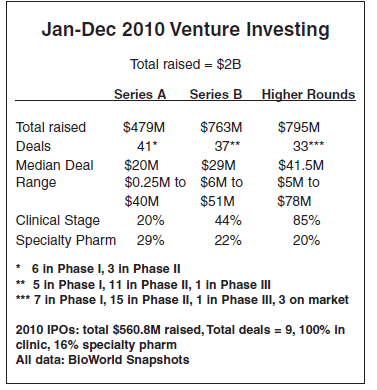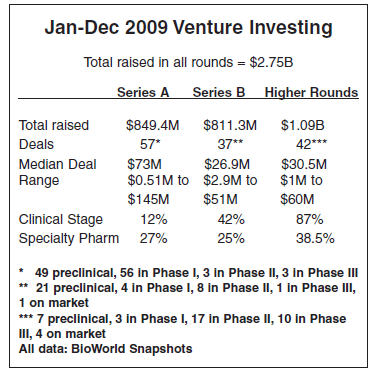BioWorld Today Columnist
The good news about fundraising in 2010: Initial public offerings (IPOs) warmed up.
Nine companies made it into the public market in 2010, raising $560.8 million. Back in 2009, only two IPOs were completed with $153.2 million added to the company coffers.
That was an improvement over recession-clobbered 2008, when BioHeart Inc. raised a measly $5.8 million in the only funded IPO that year.
The bad news: Venture funds flowing into private biotech deals totaled only $2 billion for 2010, vs. $2.75 billion the previous year.
We got lulled into a false sense of security by the constant positive trend all through 2009 – far from the $4 billion mark hit in 2007, but an improvement over 2008's $2.3 billion.
That's depressing. 2010 didn't even make it to 2008's anemic total.
So what happened last year? Where did the money go, and does it tell us anything for the coming year?
The biggest change was the 44 percent drop in early stage investing. Series A deals for companies that I categorize as biotech accounted for a mere $479 million last year, vs. $849.4 million in 2009.
Not surprisingly, fewer companies were successful in getting funded – 41 vs. 57 – in 2009. Median deal size plummeted from $73 million in 2009 to $20 million in 2010. But to be fair, Clovis Oncology Inc.'s 2009 $145 million first round jacked up the median.
There was a stronger trend for investors to reward young companies already in clinical testing, though 80 percent of the Series A dollars still went toward research and development deals.
Innovation was still a winning strategy – $340 million of the total went into companies developing novel product candidates.
The Series B rounds in 2010 looked a lot like the 2009 class – $763 million total (94 percent of 2009's total) raised by 37 companies, with a similar split of funds into clinical-stage deals and specialty pharma.
Even median deal size and range of rounds were very close for both years.
The later rounds of venture funding showed a 27 percent drop to $795 million, from a heftier $1 billion in 2009.
Fewer total deals got done (33 vs. 42), though those that were funded tended to bring in more dollars per company. A majority (85 percent) of these late-stage companies had brought at least one product candidate into the clinic, as was the case in 2009.
What Does it all Mean?
Well, some of the Series B bulge in 2010 did come from the well-funded Series A class of 2009, but not all.
It's hard to conclude much of anything except that venture investors just were not willing to pour as much into biotech start-ups as the sector entrepreneurs would like.
The IPO market certainly is not yet providing that strong pull forward that would encourage venture capitalists the sector can bring them the returns that would support raising yet another generation of their funds.
And apparently their limited partners aren't raising too much of a fuss about the unenthusiastic sector investing.
Bottom line: It looks like the biotech world is continuing to get the strong message to develop business models that generate value in the eyes of investors or corporate partners on a shoestring – a $20 million (median) shoestring. You might not get past that Series A round otherwise.
Cynthia Robbins-Roth, founding partner of BioVenture Consultants, can be reached at biogodess@earthlink.net. Her opinions do not necessarily reflect those of BioWorld Today.



